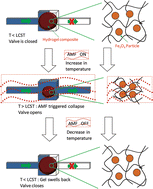In recent years, hydrogels have attracted attention as active components in microfluidic devices. Here, we present a demonstration of remote controlled flow regulation in a microfluidic device using a hydrogel nanocomposite valve. To create the nanocomposite hydrogel, magnetic nanoparticles were dispersed in temperature-responsive N-isopropylacrylamide (NIPAAm) hydrogels. The swelling and collapse of the resultant nanocomposite can be remotely controlled by application of an alternating magnetic field (AMF). A ceramic microfluidic device with Y-junction channels was fabricated using low temperature co-fired ceramic (LTCC) technology. The nanocomposite was incorporated as a valve in one of the channels of the device. An AMF of frequency 293 kHz was then applied to the device and ON–OFF control on flow was achieved. A pressure transducer was placed at the inlet of the channel and pressure measurements were done for multiple AMF ON–OFF cycles to evaluate the reproducibility of the valve. Furthermore, the effect of the hydrogel geometry on the response time was characterized by hydrogels with different dimensions. Magnetic hydrogel nanocomposite films of different thicknesses (0.5, 1, 1.5 mm) were subjected to AMF and the kinetics of collapse and recovery were studied.

You have access to this article
 Please wait while we load your content...
Something went wrong. Try again?
Please wait while we load your content...
Something went wrong. Try again?


 Please wait while we load your content...
Please wait while we load your content...